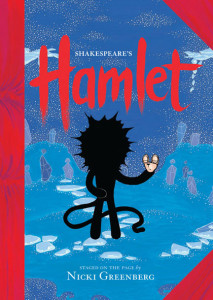Allen & Unwin
2010
 One of the fastest selling seasons of Hamlet in Britain came to a close only a few hours ago. The National Theatre’s record breaking performances at the Barbican were helped along by the pulling power of Sherlock star Benedict Cumberbatch playing the eponymous role.
One of the fastest selling seasons of Hamlet in Britain came to a close only a few hours ago. The National Theatre’s record breaking performances at the Barbican were helped along by the pulling power of Sherlock star Benedict Cumberbatch playing the eponymous role.
And while some poor sad bitter critics may have been lamenting that the audiences were not true theatre goers but merely (merely?) blindly screeching fangirls (and boys), the truth is, even if it was via the attraction of a major star, it brought an entirely fresh new audience to the experience of live theatre and perhaps has inspired them to see more. A win for theatre I would say, and every subsequent play one of those first timers sees from here on in is a fine—if invisible—middle finger to those critics who have nothing better to do than to harp and moan over the “death of theatre”.
Not that the blatant misogyny of many of those critics is anything new. Don’t try to tell me there weren’t a few swooning fans scrambling for tickets to see Peter O’Toole’s turn at the helm in 1963. Or indeed Daniel Day-Lewis, Jude Law, Ralph Fiennes, Ben Whishaw, Keanu Reeves for goodness sake. Yes, that’s right. Keanu Reeves played Hamlet. I’m as shocked as you are. And countless of others on film and television. The media has always been good at poking fun at the enthusiasm* of teenage girls and while I can rant for a few thousand words on that topic, I shall leave that for another day. Let’s move on.
Hamlet is somewhat a rite of passage for any actor of a certain age. It’s a role you just have to do at some point in your career. If not to prove that you’re a real live actor but that you can deliver those soliloquies without sounding like, well, Keanu Reeves. I’m sorry Keanu, I kid, you’re awesome.
And don’t let being a woman stop you from putting on that particular pair of Danish boots. Looking at you Sarah Bernhardt, Frances de la Tour, Asta Nielsen–actual Dane, and the sublime sublime Maxine Peake, again among many others.
But that’s the stage and screen. Another arena for Hamlet is on the page. Melbourne writer and illustrator Nicki Greenberg’s extraordinary graphic staging of the play on paper is a magnificent feast. It leaves you fully sated and hours later you’re still picking morsels from between your teeth.
Her inkblot characters roam the sets, each with their own mask capable of being removed and turned upon themselves as in Hamlet’s own “to be or not to be” soliloquy. There is a thin veil between the inkblots as their characters and the inkblots as actors, reminding us that we are watching not just a play but a play being performed.
The theme of a play within a play is played upon with, you guessed it, a play within the play. And not the play within the play but another play within the play. As we follow the characters from act to act, another story of treachery and tragedy is being played out behind the curtains.
The “real world” found object backgrounds of the backstage contrast with the painted backgrounds of the sets. Each one of the eight sets have a distinctive look for the different parts of Elsinor, and they are fluid when the need strikes. Or at least, the movement of the characters is fluid against the backdrops.
Throughout the entire story, Ophelia’s flowers are scattered, their symbolism laying a trail of clues leading to the tragic climax of all the stories, be it the play being staged or the play behind the stage.
This gorgeous hardback is a must for theatre fans, Shakespeare fans, graphic novel fans or any combination of the three. Almost every aspect, the sets, the characters, the props bear many re-readings. All have secrets lurking on the pages, at the edges and in between that you may not find until the second, third, fourth time through. Each time will reveal a new perspective, either from the pages directly or from the lens of your own life-changing experiences.
Hopefully for you, in those between times, time will not be out of joint.
*Hysteria is the loaded word they use. I would still like an explanation as to why it is perfectly socially acceptable for a grown man or woman to weep because their football team has lost but if a someone has an emotional investment in a television show or a movie or a video game or a book, well that’s just weird and unhealthy and they need to get out more. The rising plumes of anger steam are strong with this one.

